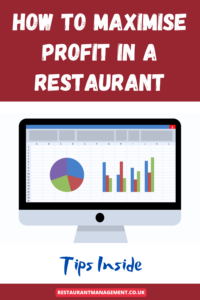Increase Your Restaurant Profits
Running a restaurant successfully requires more than just serving delicious meals—it requires sharp business sense and daily strategic decisions and the know how to maximise profit in a restaurant. With profit margins typically hovering between 3% and 6%, even small operational improvements can have a big impact on your bottom line.
Whether you own a small diner or manage a chain, smart marketing and menu strategies can help you maximise your restaurant’s profit by streamlining operations, reducing waste, improving staff performance, and increasing sales.
This guide outlines clear and simple ways to make your restaurant more profitable. From managing inventory and staff motivation to choosing high-margin food items and boosting your online presence, these proven tips can help you take your business to the next level. With the right combination of operational efficiency, customer engagement, and digital tools, even modest changes can dramatically improve your bottom line.

Operational Efficiency
Controlling costs and minimising waste are two of the fastest ways to increase your restaurant profits. The first area to focus on is inventory management. Use tools like restaurant inventory software to track usage and reduce food spoilage. For example, apps like MarketMan or BlueCart help you monitor ingredient levels in real time.
Teach your kitchen team the importance of portion control—it’s not just about consistency but protecting your profit. Even slight over-serving on each plate can quietly eat away at your margins. Use standardised recipes and portioning tools to keep quality and costs in check.
Then, take a close look at your overhead expenses—things like rent, utilities, and labour. These fixed costs can often be trimmed without compromising quality. Switch to energy-efficient lighting, stay on top of equipment maintenance to reduce utility usage, and streamline staff scheduling with smart tools like 7shifts to make every shift count.
Another overlooked area is supplier negotiations. Build long-term relationships with reliable suppliers and compare prices regularly. Even saving a few cents per item can add up to thousands of cash over the year.
Finally, conduct regular food, labour, and utilities audits to spot inefficiencies. Restaurants that consistently review operations often find hidden budget leaks that can be plugged to boost profits.

Data-Driven Decision-Making
Using your restaurant’s data can help you make smarter choices about what to sell and how to price it. One of the best sources of this data is your Point of Sale (POS) system. Modern POS tools like Toast, Square, or Lightspeed track every sale, every dish, and every transaction.
Analyse which menu items sell the most and have the highest profit margins. A lower-selling item brings in more profit per plate than your best seller. Use this information to optimise your menu—remove underperforming items and highlight high-margin dishes.
You can also use this data to improve upselling techniques. Train your servers to recommend sides, drinks, or dessert options that generate extra revenue. For example, offering a combo meal or promoting a high-margin beverage can increase average ticket size by 15% to 30%.
Making small adjustments to your menu layout can significantly impact sales. By featuring profitable items using visual elements such as boxes, bold typography, or appealing images, you can draw customers’ attention to these selections and encourage purchases. This method is called menu engineering, and it’s a proven way to boost profits without raising prices.
Remember to check data from other sources, like online reviews and social media. If a dish is trending online, make sure it’s easy to find on your menu, and consider promoting it.
Restaurant Profitability Calculator – How To Improve Restaurant Profitability Ratios
How to Maximise Profit in a Restaurant With Sales Channel Expansion
Offering more ways for customers to order helps your restaurant make more money. Expanding your ordering options is one of the best ways to improve your restaurant business.
If you haven’t already done so, consider setting up online ordering. Platforms like Uber Eats, DoorDash, and Grubhub offer quick access to delivery customers. While they do take a commission, they can increase your reach significantly. For more profit, offer direct ordering through your website, where you can avoid third-party fees and build customer loyalty.
Another practical approach is table reservations with pre-order options. Apps like OpenTable and Resy allow guests to order in advance, speeding up service and reducing table turnover times.
To adapt to changing tastes, update your menu seasonally or offer dynamic pricing—for example, lunch specials or happy hour discounts. This will make your restaurant appealing to different customer groups throughout the day.
Finally, think about offering meal kits or catering services. These can be sold through your restaurant or on platforms like Dishpatch for national reach. With lower overhead than in-house dining, meal kits can be profitable.
Expanding your sales channels increases revenue and builds a more stable business, especially during off-peak hours or in slow seasons.

How to Maximise Profit in a Restaurant With High-Profit Menu Items
The most profitable restaurants know exactly what dishes bring in the most money and build their menus around them. Here are some of the highest-margin food items you can include:
- Burgers – Easy to prepare, customisable, and beloved by customers. The cost-to-price ratio is very favourable.
- Pizzas – With inexpensive ingredients like flour, sauce, and cheese, pizzas often deliver 70 %+ profit margins.
- Pasta – Pasta dishes cost little to prepare and can be priced attractively, offering great returns.
- Sandwiches – Simple to make, versatile, and profitable during lunch and dinner hours.
- Soups and Stews – Use leftover ingredients creatively. These dishes are low-cost and can be made in bulk.
- Fried Foods – Items like fries, wings, and onion rings are crowd favourites with high markups.
- Vegetarian Dishes – Often cheaper than meat-based dishes but equally priced on menus.
And don’t forget the power of beverages. Drinks like soda, coffee, tea, and alcoholic beverages have the highest profit margins in the industry, sometimes up to 90%.
Design your menu to spotlight these items. Add photos and labels like “Chef’s Special” or “Customer Favourite” and train staff to recommend them. Smart menu design and item selection can boost your profits without increasing your workload.
Understand Your Gross Profit Margin To Unlock Restaurant Success
Marketing and Customer Engagement (250 words)
No matter how great your food is, customers need to find your restaurant. That’s where marketing and customer engagement come in. One of the best tools is social media. Platforms like Instagram, Facebook, and TikTok are powerful for showcasing your dishes, sharing promotions, and building a community.
Post regularly with high-quality photos, behind-the-scenes videos, or short clips of your staff preparing meals. Create incentives for your customers to tag your restaurant in their posts—user-generated content builds trust and reaches new audiences.
Another great tactic is starting a loyalty program. Offer rewards like a free item after 10 visits or 10% off after a particular spend. Apps like Belly or Thanx can help automate this process. Loyalty programs can increase customer return rates by up to 40%.
Search engine optimisation (SEO) is also important. Make sure your Google My Business profile is complete with photos, menu links, and updated hours. Encourage happy customers to leave reviews—they improve your local ranking and attract new visitors.
Run promotions during slow hours, such as “Happy Hour” or “Family Night.” Use coupon codes, email newsletters, or SMS to bring customers back.
The goal is to stay at the top of my mind. Engaged, loyal customers are repeat buyers and free marketers who will tell others about your restaurant.

Motivating and Retaining Staff
Your restaurant’s staff plays a big role in your success. Motivated and happy employees provide better service, which leads to happier customers and higher sales.
Start by recognising and rewarding hard work. Bonuses, public praise, and small gifts like gift cards or free meals can go a long way. Consider giving “Employee of the Month” awards or naming a menu item after your top performer.
Create a positive work culture with team-building events like trivia nights, cooking competitions, or group outings. These activities help build strong bonds and improve morale.
Set clear expectations and offer training to help staff grow. When employees grasp their responsibilities and perceive a sense of support, they are more inclined to remain with the company for an extended period. Use goal setting to help team members improve and track their progress.
Offering flexible scheduling helps improve work-life balance, which is very important in the fast-paced restaurant industry.
Also, encourage open communication. Let staff share feedback and suggestions. A simple “How can we do better?” can lead to helpful insights you may not have considered.
High staff turnover comes with a hefty price tag. In the UK, replacing a single hospitality employee can cost businesses upwards of £1,500 to £2,000, once you factor in recruitment, training, and lost productivity. Investing in your existing team is more cost-effective and strengthens loyalty, improves morale, and enhances overall service quality.
Most Profitable Restaurant Types
Some types of restaurants naturally bring in more profit than others. If you’re starting out or thinking of pivoting your concept, consider the following:
- Fast Food Restaurants
Low-cost ingredients, quick service, and high customer volume make fast food one of the most profitable models. Chains like McDonald’s enjoy margins of up to 20%.
- Quick-Service Restaurants (QSR)
QSRs offer slightly higher-end meals than fast food, often with limited seating. Think of food trucks, sandwich shops, or salad bars. They combine speed with fresh appeal.
- Ethnic or Niche Cuisine
Offering specialised food (e.g., Thai, vegan, or Middle Eastern) can attract loyal customers looking for unique dishes. These types also have less competition in many markets.
- Delivery-Only Kitchens (Ghost Kitchens)
With no dine-in space, these operations cut down on rent and utility costs. They are perfect for launching a brand with low startup capital.
Choosing the right model depends on your location, budget, and customer base—but these types are generally more cost-effective and profitable.

Related articles:
Restaurant Profitability Calculator
Restaurant Gross Profit Margin
Top 10 Most Profitable Fast-Food Franchises In The UK
How to Open a Successful Takeaway Restaurant in the UK
Conclusion
How to maximise a restaurant profits doesn’t require significant changes, it just needs the right strategy. Focus on cutting costs, using your data wisely, promoting profitable items, engaging with customers online, and treating your team well. Small improvements in many areas can lead to significant results that would increase your restaurant profits.
To keep your restaurant successful, focus on high-margin dishes, explore new sales channels, and build strong relationships with customers and staff.
Be consistent, keep making improvements, and don’t hesitate to try new ideas. Your next big profit boost could be just one smart idea away.
Restaurant Menu Planning: 12 Tips On How to Design the Perfect Restaurant Menu


